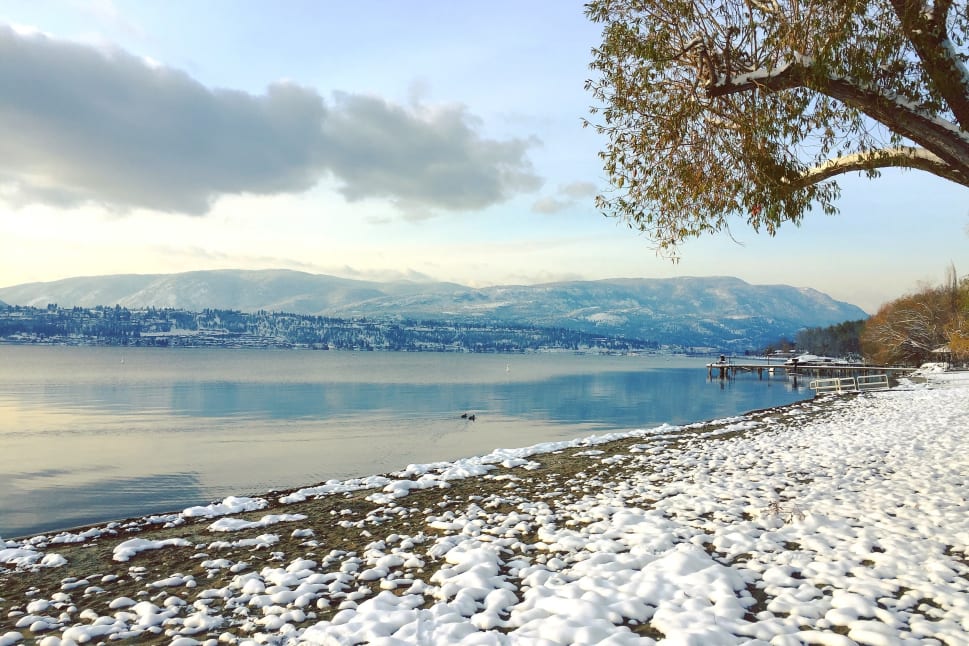Capturing the beauty of Osoyoos in winter offers photographers a unique opportunity to showcase this region's serene landscapes, frozen lakes, and tranquil charm. This guide highlights the best spots for winter photography, providing detailed descriptions to help you get the perfect shot.
Osoyoos Lake
Osoyoos Lake is a prime location for winter photography. Often partially frozen in winter, the lake contrasts with the surrounding snow-covered mountains. Early and late afternoons are the best lighting, creating beautiful reflections and serene compositions. The lake's accessibility from various points around town makes it a convenient and scenic spot for capturing winter's beauty.
The stillness of the frozen lake against the backdrop of snowy peaks offers countless opportunities for striking images. Try capturing the reflections of the mountains in the water or the patterns formed by the ice and snow on the lake's surface.
Spotted Lake
Just a short drive west of Osoyoos, Spotted Lake is another fantastic photography spot. Known for its unique mineral deposits, the lake forms distinctive spots that can be particularly striking when dusted with snow. Although access to the lake is restricted, plenty of vantage points along Highway 3 offer excellent views. The unique patterns and natural formations make it a must-visit for photographers looking to capture something genuinely different.
The contrast between the snow and the mineral-rich spots creates an otherworldly landscape. This location is especially magical at sunrise or sunset when the light enhances the natural colours and textures.
Mount Kobau
Mount Kobau offers panoramic views of the Okanagan and Similkameen Valleys, making it a perfect location for landscape photography. The trail to the summit is about 5 km long and provides various scenic spots. The summit, accessible via Highway 3, offers unobstructed views of the surrounding valleys, incredibly stunning during sunrise and sunset when the low light accentuates the snow-covered peaks and valleys.
The hike to the top is well worth it, providing ample opportunities to capture the vast, sweeping landscapes. In winter, the snow-covered trails and trees add a layer of texture and contrast, enhancing the beauty of your photos.
Sẁiẁs Provincial Park
Located just south of Osoyoos, Sẁiẁs Provincial Park is a great spot for capturing the natural beauty of wetlands and diverse wildlife. The park's trails and boardwalks offer excellent vantage points for photographing birds and other wildlife against snow-covered reeds and trees. The stillness of the winter months enhances the peacefulness and beauty of this location, providing ample opportunities for tranquil and reflective shots.
Early mornings are the best time to visit, as the soft light and calm atmosphere create a perfect setting for wildlife photography. Look for reflections in the water and the play of light and shadows among the trees.
Osoyoos Desert Centre
The Osoyoos Desert Centre offers a striking contrast for a unique winter landscape with its arid environment dusted with snow. The 67-acre interpretive facility features a 1.5 km boardwalk that winds through the antelope-brush ecosystem. This area is particularly photogenic during winter when the unusual combination of desert flora and snow creates a surreal and captivating scene.
The boardwalk provides various perspectives and angles, allowing you to experiment with different compositions. The juxtaposition of snow on desert plants makes for compelling and unexpected images.
Tips for Winter Photography
Gear and Preparation
Winter photography requires special preparation to protect both yourself and your equipment. Dress in layers to stay warm and protect your camera against the cold. Use a tripod to stabilize your shots, especially in low light conditions typical of winter. Extra batteries are a must, as cold weather can drain them quickly.
Lighting and Timing
The quality of light in winter can be exceptional, with the sun lower in the sky providing long shadows and soft light throughout the day. Early morning and late afternoon are the best times to shoot, offering the golden hour light that enhances the snowy landscapes. Overcast days can also be beneficial, providing diffused light that reduces harsh shadows and highlights.
Composition
When composing your shots, look for interesting foreground elements such as snow-covered trees, rocks, or footprints in the snow. These elements can add depth and interest to your photos. Reflections in partially frozen lakes can create stunning mirror images, dramatically affecting your compositions.
Winter in Osoyoos transforms the landscape into a serene and captivating scene, perfect for photography. With these prime locations and tips, you're well-equipped to capture the nature of Osoyoos in winter.





